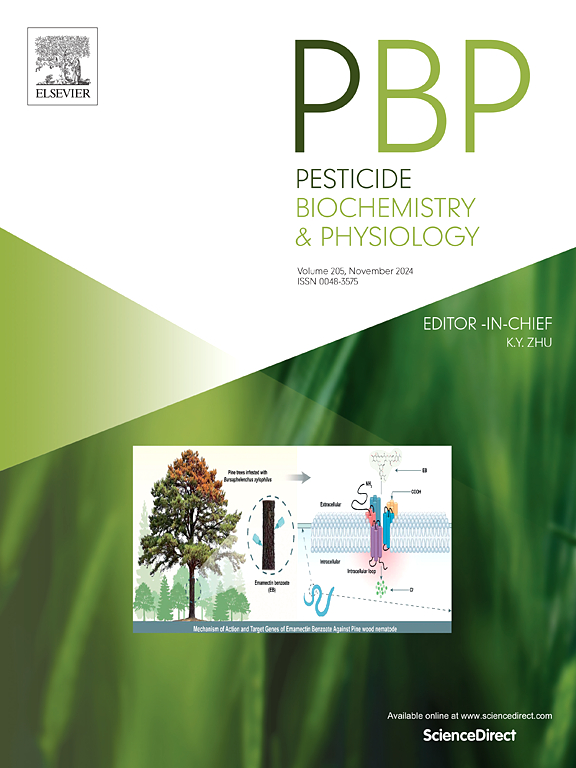Involvement of AhR/ARNT in tolerance to deltamethrin by regulating the expression of TcGSTs6 in Tribolium castaneum
IF 4.2
1区 农林科学
Q2 BIOCHEMISTRY & MOLECULAR BIOLOGY
引用次数: 0
Abstract
It is well known that the transcription factors aryl hydrocarbon receptor (AhR) and aryl hydrocarbon receptor nuclear translocator (ARNT) play important roles in the detoxification of xenobiotic compounds including insecticides. In this study, TcAhR and TcARNT were cloned from Tribolium castaneum. RT-qPCR analysis revealed that TcAhR and TcARNT were highly expressed in brain and epidermis of female adults and upregulated after exposure of the adults to deltamethrin. Knockdown of TcAhR and TcARNT increased the susceptibility of T. castaneum to deltamethrin and decreased the enzymatic activity of Glutathione S-transferase (GST). Consistently, knockdown of TcAhR and TcARNT led to the downregulation of TcGSTs6 and suppressed the induction of TcGSTs6 by deltamethrin treatment. Increased susceptibility of T. castaneum to deltamethrin was also observed after knockdown of TcGSTs6. Further dual-luciferase reporter assay revealed that co-overexpression of TcAhR and TcARNT in Sf9 cells significantly enhanced the promoter activity of TcGSTs6. These results provided insights into the function of insect AhR and ARNT as well as the regulatory mechanisms of insect GSTs.

求助全文
约1分钟内获得全文
求助全文
来源期刊
CiteScore
7.00
自引率
8.50%
发文量
238
审稿时长
4.2 months
期刊介绍:
Pesticide Biochemistry and Physiology publishes original scientific articles pertaining to the mode of action of plant protection agents such as insecticides, fungicides, herbicides, and similar compounds, including nonlethal pest control agents, biosynthesis of pheromones, hormones, and plant resistance agents. Manuscripts may include a biochemical, physiological, or molecular study for an understanding of comparative toxicology or selective toxicity of both target and nontarget organisms. Particular interest will be given to studies on the molecular biology of pest control, toxicology, and pesticide resistance.
Research Areas Emphasized Include the Biochemistry and Physiology of:
• Comparative toxicity
• Mode of action
• Pathophysiology
• Plant growth regulators
• Resistance
• Other effects of pesticides on both parasites and hosts.

 求助内容:
求助内容: 应助结果提醒方式:
应助结果提醒方式:


